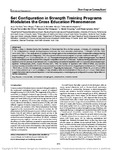Mostrar o rexistro simple do ítem
Set configuration in strength training programs modulates the cross education phenomenon
| dc.contributor.author | Carballeira, Eduardo | |
| dc.contributor.author | Iglesias-Soler, Eliseo | |
| dc.contributor.author | Mayo, Xián | |
| dc.contributor.author | Fernández-del-Olmo, Miguel | |
| dc.contributor.author | Rial-Vázquez, Jessica | |
| dc.contributor.author | Fariñas Rodríguez, Juan | |
| dc.contributor.author | Giráldez-García, Manuel Avelino | |
| dc.contributor.author | Kingsley, J. Derek | |
| dc.date.accessioned | 2024-04-15T15:18:35Z | |
| dc.date.issued | 2021-09 | |
| dc.identifier.citation | Fariñas, J, Mayo, X, Giraldez-García, MA, Carballeira, E, Fernandez-Del-Olmo, M, Rial-Vazquez, J, Kingsley, JD, and Iglesias-Soler, E. Set configuration in strength training programs modulates the cross education phenomenon. J Strength Cond Res 35(9): 2414–2420, 2021. DOI: 10.1519/JSC.0000000000003189 | es_ES |
| dc.identifier.issn | 1064-8011 | |
| dc.identifier.uri | http://hdl.handle.net/2183/36194 | |
| dc.description.abstract | [Abstract]: This study aimed to compare the strength gains in the nontrained arm after 2 independent unilateral training programs differing in the set configuration. Thirty-five subjects were randomly assigned to 3 groups: traditional training (TT; n = 12), cluster training (CT; n = 11), or control (CON; n = 12). The experimental groups performed a 5-week training program of a unilateral biceps curl exercise with the dominant limb using the 10 repetition maximum (10RM) load. Traditional training performed 5 sets of 6 repetitions and 135 seconds of rest between sets. Cluster training completed 30 repetitions with 18.5 seconds of rest between each repetition. Anthropometry (ANT), muscle thickness (MT), 1RM, the number of repetitions with 10RM (n10RM), and isometric maximal voluntary contraction (MVC) were measured before and after the intervention. Regarding the nontrained arm, TT improved 1RM (7.3%, p < 0.001). No changes were observed in CT. Regarding the trained arm, TT improved 1RM (9.1%, p < 0.001), n10RM (p = 0.005), and MVC (p = 0.011), whereas CT only showed a trend for improvement of 1RM (3.4%, p = 0.052). These results suggest that when total volume and repetition-to-rest ratio are equated, a more fatiguing set configuration causes a higher effect on the non-trained limb. | es_ES |
| dc.language.iso | eng | es_ES |
| dc.publisher | Wolters Kluwer | es_ES |
| dc.relation.uri | https://doi.org/10.1519/JSC.0000000000003189 | es_ES |
| dc.rights | Copyright © 2019 National Strength and Conditioning Association | es_ES |
| dc.subject | Cross transfer | es_ES |
| dc.subject | Contralateral strength gains | es_ES |
| dc.subject | Untrained limb | es_ES |
| dc.subject | Interlimb transfer | es_ES |
| dc.title | Set configuration in strength training programs modulates the cross education phenomenon | es_ES |
| dc.type | info:eu-repo/semantics/article | es_ES |
| dc.rights.access | info:eu-repo/semantics/embargoedAccess | es_ES |
| dc.date.embargoEndDate | 9999/99/99 | es_ES |
| dc.date.embargoLift | 9999 | |
| UDC.journalTitle | Journal of Strength and Conditioning Research | es_ES |
| UDC.volume | 35 | es_ES |
| UDC.issue | 9 | es_ES |
| UDC.startPage | 2414 | es_ES |
| UDC.endPage | 2420 | es_ES |
| dc.identifier.doi | https://doi.org/10.1519/JSC.0000000000003189 |
Ficheiros no ítem
Este ítem aparece na(s) seguinte(s) colección(s)
-
GI-PHG - Artigos [75]






